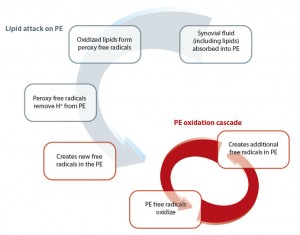![]()
Successes and Setbacks with Highly Crosslinked Polyethylene
Highly crosslinked polyethylene (XLPE) was developed to address the two major factors known to affect polyethylene longevity in vivo: wear and oxidation.[1] While the XLPE process varies among manufacturers, generally it includes: radiation crosslinking for wear resistance and thermal annealing to address oxidation.
Proven Wear Reduction—with Drawbacks
Laboratory and clinical studies of first-generation XLPE have verified that radiation crosslinking results in improved wear when compared to conventional* polyethylene.[2-10] However, improved wear and resistance to oxidation come at the expense of mechanical properties.[11-15]
| Drawbacks Associated with First-Generation XLPE | ||
| Process Step | Benefit | Drawback |
|---|---|---|
| Crosslinking ( |
||
| Melt-Anneal ( |
||
Unexpected In Vivo Surface Damage and Oxidation
Several reports of surface damage and catastrophic failure in first-generation XLPE hip liners have been published.[16-19] Researchers have noted pitting, cracking, and surface wear similar to conventional polyethylene.[20-24] More recent retrieval studies of melt-annealed XLPE liners have also revealed unexpected findings regarding oxidation, citing:
- Measurable oxidation potential [23]
- Increased oxidation with longer implantation time [24]
- Evidence that free radicals are re-introduced in vivo [11]
Researchers theorize that the free radicals are introduced when lipids are absorbed into the polyethylene, triggering the oxidation cascade. [11]
Proposed Process for in vivo Oxidation of Melt-Annealed XLPE [11]
*The term “conventional” refers to the control in published studies of XLPE: gamma-sterilized-in-air and, more recently, oxygenless-packaged PE.
- Muratoglu OK. Chapter 13 Highly Crosslinked and Melted UHMWPE. In UHMWPE Biomaterials Handbook Second Edition (ed. Kurtz SM). Elsevier: Amsterdam, 2009.
- Kurtz S, Medel FJ, MacDonald D, Rimnac CM. In vivo oxidation, oxidation potential, and clinical performance of highly crosslinked UHMWPEs implanted for up to 8 years. 4th International Meeting UHMWPE for arthroplasty: From Powder to Debris 2009; Torino, Italy.
- Digas G, Karrholm J, Thanner J, Herberts P. 5-year experience of highly cross-linked polyethylene in cemented and uncemented sockets: Two randomized studies using radiostereometric analysis. Acta Orthop 2007; 78(6): 746-54.
- D’Antonio JA, Manley MT, Capello WN, et al. Five-year experience with Crossfire highly cross-linked polyethylene. Clin Orthop Relat Res 2005; 441: 143-50.
- Engh CA, Stepniewski AS, Ginn SD, et al. A randomized prospective evaluation of outcomes after total hip Arthroplasty using crosslinked marathon and non-cross-linked Enduron polyethylene liners. J Arthroplasty 2006; 21(6): 17-25.
- Olyslaegers C, Defoort K, Simon JP, Vandenberghe L. Wear in conventional and highly cross-linked polyethylene cups: a 5-year follow-up study. J Arthroplasty 2008; 23(4): 489-94.
- Garcia-Rey E, Garcia-Cimbrelo E, Cruz-Pardos A, Ortega-Chamarro J. New polyethylenes in total hip replacement: a prospective, comparative clinical study of two types of liner. J Bone Joint Surg Br 2008; 90(2): 149-53.
- Geerdink CH, Grimm B, Vencken W, Heyligers IC, Tonino AJ. Cross-linked compared with historical polyethylene in THA: An 8-year clinical study. Clin Orthop Relat Res 2009; 467(4): 979-84.
- Glyn-Jones S, Isaac S, Hauptfleisch J, McLardy-Smith P, Murray DW, Gill HS. Does highly cross-linked polyethylene wear less than conventional polyethylene in total hip arthroplasty? A doubleblind, randomized, and controlled trial using roentgen stereophotogrammetric analysis. J Arthroplasty 2008; 23(3): 337-43.
- Kurtz SM, Medel FJ, MacDonald DW, Parvizi J, Kraay MJ, Rimnac CM. Reasons for revision of first-generation highly cross-linked polyethylenes. J Arthroplasty. 2010 Sep;25(6 Suppl):67-74.
- Muratoglu OK, Wannomae KK, Rowell SL, et al. Ex Vivo Stability Loss of Irradiated and Melted Ultra-High Molecular Weight Polyethylene. JBJS 2010;92:2809-2816.
- Kurtz SM. Chapter 6 Contemporary total hip arthroplasty: hard-on-hard bearings and highly crosslinked UHMWPE. In UHMWPE Biomaterials Handbook Second Edition (ed. Kurtz SM). Elsevier: Amsterdam, 2009.
- Oral E, Malhi AS, Muratoglu OK. Mechanisms of decrease in fatigue crack propagation resistance in irradiated and melted UHMWPE. Biomaterials. 2006; 27(6):917-25.
- Baker DA, Bellare A, Pruitt L. The effects of degree of crosslinking on the fatigue crack initiation and propagation resistance of orthopedic-grade polyethylene. Journal of Biomedical Materials Research 2003; 66A(1): 146-154.
- Rimnac C. On the mechanical properties of UHMWPE. Transactions of the 3rd UHMWPE International Meeting. Polyethylene in Total Joint Replacement Systems: Concerns and Solutions. Madrid, Spain. September 14-15, 2007.
- Tower SS, Currier JH, Currier BH, Lyford KA, Van Citters DW, Mayor MB. Rim cracking of the cross-linked Longevity polyethylene acetabular liner after total hip arthroplasty. JBJS 2007; 89(10): 2212-2217.
- Halley D, Glassman A, Crowninshield RD. Recurrent dislocation after revision total hip replacement with a large prosthetic femoral head. A case report. JBJS 2004; 86(4):827-830.
- Moore KD, Beck PR, Petersen DW, Cuckler JM, Lemons JE, Eberhardt AW. Early failure of a cross-linked polyethylene acetabular liner. A case report. JBJS 2008; 90(11):2499.
- Duffy GP, Wannomae KK, Rowell SL, Muratoglu OK. Fracture of a crosslinked polyethylene liner due to impingement. J Arthroplasty 2009; 24(1): 158.e15-158.e19.
- Bradford L, Baker DA, Graham J, Chawan A, Ries MD, Pruitt LA. Wear and surface cracking in early retrieved highly cross-linked polyethylene. JBJS 2004;86-A(6):1271-82.
- Furmanski J, Kraay MJ, Rimnac CM. Crack Initiation in Retrieved Cross-Linked Highly Cross-Linked Ultrahigh-Molecular-Weight Polyethylene Acetabular Liners: An Investigation of 9 Cases. J Arthroplasty. 2010 Sep 20. [Epub ahead of print]
- Schroder DT, Kelly NH, Wright TM, Parks ML. Retrieved highly crosslinked UHMWPE acetabular liners have similar wear damage as conventional UHMWPE. Clin Orthop Relat Res 2010; 469(2):387-94.
- Kurtz SM, MacDonald D, Brenner E, Medel FJ, Hozack W, Parvizi J, Goldberg V, Kraay M, Stulberg B, Rimnac CM. In vivo oxidation, oxidation potential, and clinical performance of first and second generation highly crosslinked acetabular bearings for THA. Poster No. 1790 54th Annual Meeting of the ORS, 2008.
- Currier BH, Van Citters D., Currier JH, Collier JP. In Vivo Oxidation in Remelted Highly Cross-Linked Retrievals. JBJS 2010; 92(14):2409-18.
